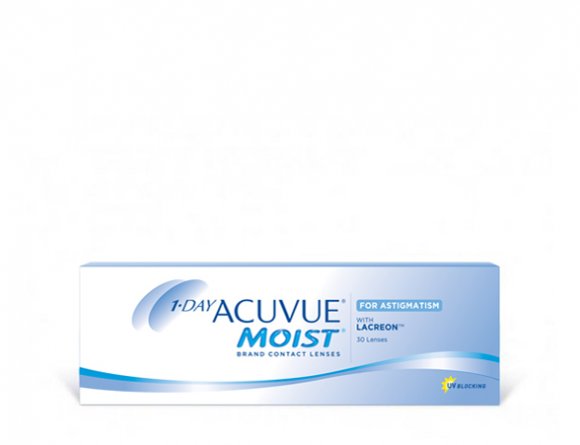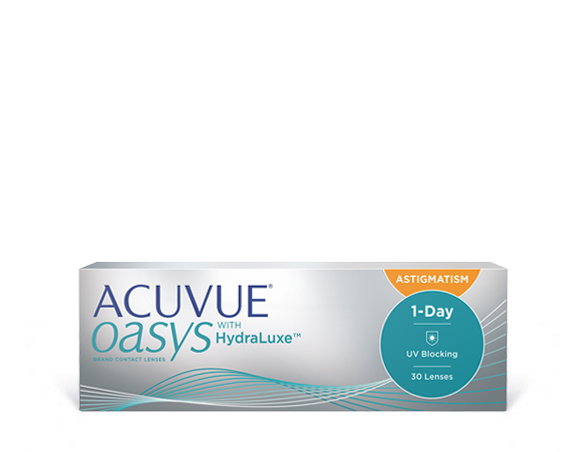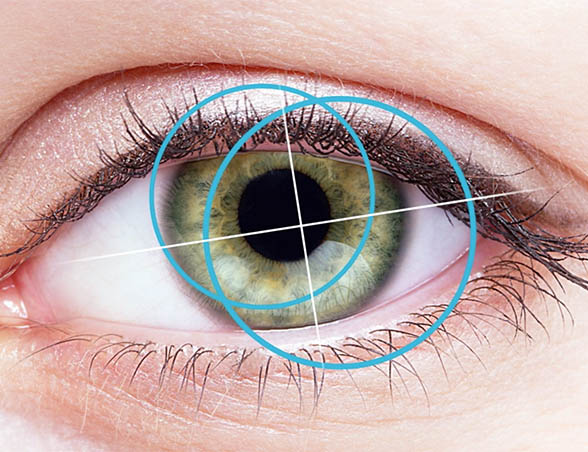1-DAY ACUVUE® MOIST Contact Lenses for ASTIGMATISM
1-DAY ACUVUE® MOIST Contact Lenses for ASTIGMATISM
1-DAY ACUVUE® MOIST contact lenses for ASTIGMATISM. A daily disposable contact lens with LACREON® Technology4 designed for clear, stable vision1
Instructional Guides
Instructional Guides
Instructional Guides
For patients with astigmatism who need clear and stable vision and who feel their eyes are prone to sensitivity, irritation or allergies and want to comfortably enjoy everyday activities.
1-DAY ACUVUE® MOIST for ASTIGMATISM integrates EYE-INSPIRED™ Innovations proprietary Eyelid Stabilised Design1
• Unbeaten in comfort in 14 clinical studies posted on ClinicalTrials.gov when compared to other hydrogel daily disposable contact lenses†
• Category-wide range of parameters to satisfy the vision needs of your spherical, astigmatic, and presbyopic patients2$
• Covers 87% of astigmatic eyes with 2260 parameters3
• Built-in EYELID STABILISED Design which utilise four stabilisation zones with the lids to help keep the lens in place, even with eye or head movements, for consistent, clear and stable vision1
EYELID STABILISED Design helps provide clear and stable vision so you can enjoy your regular activities1
1-DAY ACUVUE® MOIST integrates EYE-INSPIRED™ Innovations1:
• EYELID STABILISED Design for astigmatism1
• Antioxidants to support comfort1
• UV-blocking for eye health1¶
• Moisture-infused for hydration1
• Invisible edge for comfort1
8.5 mm base curve/14.5 mm diameter
Sphere:
-6.50D to -9.00D (in 0.50 D steps)
0.00D to -6.00D (in 0.25 D steps)
+0.25D to +4.00D (in 0.25 D steps)
Cylinders:
-0.75D, -1.25D, -1.75D, -2.25D*
Axes:
10°-180° in 10° steps for 0.00D to -6.00D
10°, 20°, 70°-110° and 160°-180° (in 10° steps) for -6.50D to -9.00D and +0.25D to +4.00D
*cylinder -2.25D available in power range 0.00D to -6.00D and axes 10°, 20°, 70°-110° and 160°-180° (in 10° steps)
| Lens material | etafilcon A |
| Technology | LACREON® Technology and EYELID STABILISED Design |
| Dk/t (boundary & edge corrected)4◊ | 23.8 x 10-9 |
| Water content | 58% |
| FDA classification | Group 4 |
| UV blocker4¶ | Class 2 98.8% UVB, 85.1% UVA |
| Centre thickness at -3.00D (mm) | 0.090 |
| Inside-out mark | No |
| Visibility tint | Yes |
| Package size | 30 |
EYELID STABILISED Design is based on a four-zone stability system that utilises positive eyelid interaction by harnessing the power of the eye blink1
Benefits of LACREON® Technology:
• Locked-in wetting agent PVP, creates a long-lasting cushion of moisture from the core to the surface of the lens. 5,6
• Etafilcon A helps keep the tear film enzyme, Lysozyme, in its natural state, which has been shown in vitro to help maintain low levels of inflammatory biomarkers released by the corneal epithelium that can lead to irritation. 7#
†14 clinical studies posted on ClinicalTrials.gov, a website maintained by the NIH, evaluated subjective comfort as a primary or secondary endpoint for 1-DAY ACUVUE® MOIST brand family (spherical, astigmatism, and multifocal) contact lenses vs. competitors’ products. Published trials include comparisons between etafilcon A and nelfilcon A, omafilcon A, hilafilcon B, ocufilcon D and nesofilcon A. Review conducted as of April 30, 2023.
$Based on publicly available manufacturer information as of March 2020
^Hyperope SKUs available in 30 pack only
◊Oxygen is only one of several factors related to maintaining overall eye health when wearing contact lenses.
¶All ACUVUE® contact lenses have Class 1 or Class 2 UV-blocking to help provide protection against transmission of harmful UV radiation to the cornea and into the eye. UV-absorbing contact lenses are NOT substitutes for protective UV-absorbing eyewear such as UV-absorbing goggles or sunglasses because they do not completely cover the eye and surrounding area.
#Based on in-vitro data, clinical studies have not been done directly linking differences in lysozyme profile with specific clinical benefits.
Packing solution contains boric acid and disodium tetraborate (sodium borate) to control the pH of the solution.
References
1. JJV Data on File 2021. ACUVUE Brand Contact Lenses for ASTIGMATISM - Overall Fitting Success, Orientation Position, Rotational Stability, and Vision Performance.
2. JJV Data on File 2020. 1-DAY ACUVUE MOIST Family Parameters Coverage
3. JJV Data on File 2021. Proportion Astigmats Accommodated with ACUVUE® Brand Contact Lenses for ASTIGMATISM.
4. JJV Data on File 2022. Material Properties: 1-DAY ACUVUE MOIST, 1- DAY ACUVUE TruEye, ACUVUE OASYS 1-Day with HydraLuxe Technology and ACUVUE OASYS MAX 1-Day with TearStable Technology Brand Contact Lenses.
5. JJV Data on File 2018. Similarities between Mucin and Poly(N-Vinyl Pyrrolidone) (PVP).
6. JJV Data on File 2018. Dual Action Technology and "Cushion of Moisture" Description for 1-DAY ACUVUE MOIST Brand Family of Contact Lenses
7. Heynen M, Omali NB, Fadli Z, et al. Selectivity and localization of lysozyme uptake in contemporary hydrogel contact lens materials. J Biomater. Sci. Polym. Ed. 2017;28(13):1351-1364.
Important Safety Information
ACUVUE® Contact Lenses are indicated for vision correction. As with any contact lenses, eye problems, including corneal ulcers, can develop. Some wearers may experience mild irritation, itching or discomfort. Contact lenses should not be used in case of eye infections or any other eye conditions, or in case of a systemic disease that may affect the eye. For detailed product information, including contraindications, precautions and adverse reactions, please consult the Instructions for Use or visit (http://www.e-ifu.com/)
PP20231DAVM4372





